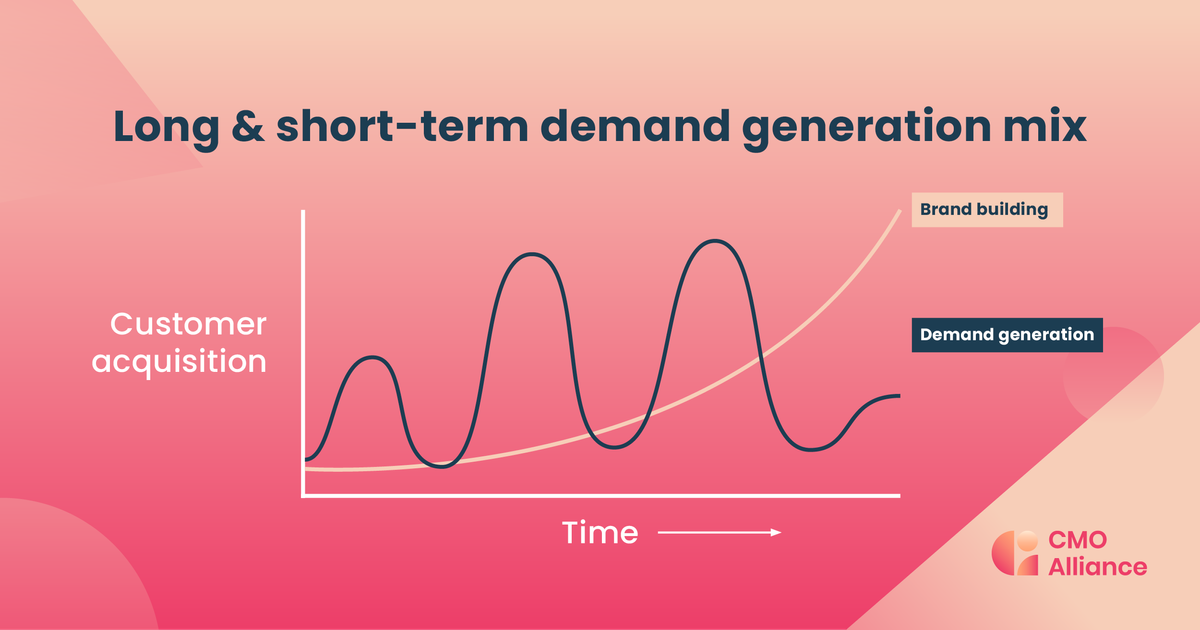Embarking on the journey of long-term marketing and brand strategy is a challenge that every CMO must embrace so you can shape the future trajectory of a brand.
I’m Ariadna Navarro, Chief Growth Officer at VSA Partners, and my path has been focused on bridging the gap between immediate business needs and long-term brand evolution.
In this article, I’ll share insights into how CMOs can effectively align their strategies with company goals, foster essential partnerships, and drive meaningful change, all while maintaining the agility to adapt to the ever-evolving business landscape.
Prefer to listen? Check out Ariadna's appearance on the CMO Convo podcast 👇
Rethinking the role of CMO in modern organizations
It's a thought-provoking question why CMOs often have short tenures, especially given their involvement in long-term projects like brand building. However, I believe the issue isn't just about the time given to CMOs but rather how organizations perceive the brand itself.
In many large, legacy companies, the brand has been traditionally seen as synonymous with advertising or public relations — essentially, the 'fluff' of the business. This perception relegates the CMO to a cost center rather than a change agent or a driver of business transformation and growth. The CMO is often viewed merely as the person managing advertising or communications, whether in a B2B or B2C context.
However, there's been an evolution in this mindset. Now, we see the emergence of titles like 'Chief Marketing and Growth Officer.' This shift signifies a broader role where the focus extends beyond advertising to encompass responsibility for the organization's profit and loss and meeting hard key performance indicators (KPIs).
This change necessitates viewing the brand as a strategic business asset. If the brand is the best articulation of your business strategy, it becomes a framework for making all business decisions. This perspective influences not just communications and PR, but also product development, services, innovation, employee engagement, and the overall experience.
This approach moves the brand from being an endpoint to a central part of running the organization. It's about aligning business strategy with brand strategy. When this pivot occurs within an organization, the CMO's role fundamentally changes.
They are no longer just responsible for communications but become the bearer of the business's ambition. This transformation requires the CMO to work closely with different groups within the organization, taking on a more integrated and strategic role.

The CMO's role in fostering internal alignment and driving innovation
Addressing the other long-term responsibilities of CMOs, it's crucial to understand that everything starts from within the organization. If there's a misalignment between the brand's external image and its internal ethos, it creates cognitive dissonance. This inconsistency becomes evident, especially during hiring processes.
Prospective employees form their perceptions based on the company's external image, which may be the only data point they have, especially in hardcore B2B scenarios where public exposure is minimal.
To create a consistent ethos, it's essential to align the Customer Value Proposition (CVP) and the Employee Value Proposition (EVP). These two should be closely related, like siblings or first cousins, as they are two sides of the same coin. What a company promises externally must resonate internally with what motivates its employees. This alignment is challenging, especially for older organizations with long histories and traditional operating models.
In my experience, integrating the CVP and EVP often falls under the agency's responsibility, involving CMOs or brand teams collaborating with HR and talent acquisition teams. The goal is to ensure that the external facing promises translate effectively into internal commitments. This foundational work requires intellectual effort to ensure coherence between these two aspects.
The CMO, in this context, can play a pivotal role as the 'uniter' or 'translator in chief,' articulating the business's ambition in a compelling and human way. This role extends to various areas of the organization, such as HR, talent acquisition, service and product innovation teams. It's about ensuring that the brand's promise and ethos are reflected in every product, service, and internal process.
For instance, if a brand stands for simplicity but offers a complex product portfolio, there's a clear discrepancy. Aligning the brand promise with product development and customer experience is critical. In many organizations, these functions operate in silos, but the CMO's role could be to facilitate collaboration between different departments – like marketing, service, HR, and finance – to work as unified teams. This approach not only ensures consistency in brand messaging and experience but can also lead to significant cost savings.
The role of a CMO or a Chief Marketing and Growth Officer is expanding. It involves being the common thread that connects digital experience, design, product innovation, HR, talent acquisition, and even finance. This broadened scope requires moving beyond traditional marketing silos to embrace a more integrated and strategic role within the organization.
Leveraging process to build trust and accelerate transformation in CMO roles
Building trust and forming partnerships within the C-suite is indeed a significant challenge for CMOs, especially in an era where hybrid and remote work are prevalent. This lack of face-to-face interaction in the office can hinder rapport building with key figures like the CFO or head of sales.
However, I believe in using process as a tool to hack transformation, which is inherently a long-term endeavor. This approach can help accelerate the building of trust and partnerships.
Traditionally, trust is built over time through numerous conversations, pilot programs, and demonstrations of success. This gradual process of creating adherence can be effective but is time-consuming. The key challenge is the differing KPIs among teams.
For example, in the automotive industry, where I have substantial experience, dealership-level partners are primarily focused on immediate sales goals, often evaluated on a daily or weekly basis. This focus can make conversations about brand development seem disconnected from their immediate goals.
The CEO's role is crucial in aligning the organization around common goals and KPIs. For a CMO, proving the correlation between brand investment and sales is essential, yet challenging. Sales results are often immediate, while brand development is a long-term process, sometimes taking years to manifest tangible benefits like better quality leads or increased trust.
To overcome this, CMOs need to be intentional in building their case. This involves selecting specific actions or initiatives, demonstrating their effectiveness through pilot projects, and then presenting these as proof of concept.
This approach isn't about being self-serving; it's about showing how these initiatives can lead to running a better business. Ultimately, no one would oppose initiatives that are proven to improve business performance. However, the key lies in being able to effectively demonstrate these outcomes.

Gaining buy-in for long-term brand-building
When considering how to gain buy-in for a long-term brand-building project, it's crucial to start with stakeholders who genuinely believe in the power of the brand. This may sound simplistic, but it's foundational. If the people at the business unit (BU) level, those responsible for the actual business and holding the budgets, don't understand or believe in the brand's value, it becomes an uphill battle.
Ideally, you want these BU-level stakeholders as your partners. However, if that support isn't there, then it’s vital to have a CEO who believes in the brand's power. Constantly having to prove the brand's worth at every turn can lead to burnout, as I've seen with CMOs expressing frustration and feeling unable to effect change within their organizations.
The challenge is often rooted in differing metrics for success. For example, if a team is measured solely by sales or immediate metrics like engagement or clicks, they might prioritize short-term tactics over long-term brand strategy. This mismatch in KPIs can create a disconnect between what's best for the brand long-term and what's being rewarded in the short term.
To address this, it’s important to establish common KPIs and a mutual understanding of how different teams can support each other towards these shared goals. I've observed organizations creating intermediary teams that bridge the gap between the brand/marketing teams and the business units. These teams act almost like consultants, ensuring that the execution of strategies aligns with the intended vision and doesn't devolve into short-term sales tactics.
This approach can serve as an effective temporary solution, a kind of 'band-aid,' to facilitate better alignment and execution. It's a way to 'hack' behavior change through process until seamless collaboration is achieved. These intermediary teams can be instrumental in ensuring that the strategic thinking and actions derived from it remain true to their original intent and don’t just become sales-driven tactics.

The challenge of measuring success and gaining buy-in for brand-building
Measuring the success of brand-building activities and gaining buy-in for these initiatives is an area I am deeply passionate about. The goal is to identify early indicators of change, which can be quite challenging but immensely valuable. For instance, if we track a podcast over a year and observe its peaks and valleys, we learn from these patterns.
With several years of data, we can develop diagnostic models to pinpoint early indicators of change, like a correlation between weather and podcast downloads. This insight allows for more informed investment decisions.
However, the current state of brand measurement is often too immediate, focusing on touchpoint optimization geared towards immediate sales rather than long-term value. This short-term view is a significant challenge because we have evidence that strong brands correlate with higher market capitalization. This is evident in the stock market, where the most recognized and admired brands often have the highest value.
The importance of investing in brand-building is even more pronounced in B2B contexts. Numerous studies from esteemed organizations like Harvard, McKinsey, and Gartner have shown that brand matters significantly in B2B due to issues of trust and risk mitigation.
For example, when a company invests a million dollars with a firm like IBM, the risk involved is considerably higher than purchasing a $3 tube of toothpaste. In such high-stake scenarios, brand trust becomes even more critical.
While the proof of the importance of brand investment is clear, changing long-standing behaviors and perspectives in companies remains a hurdle. Many large organizations, accustomed to a product-centric or sales-driven approach, find it challenging to consolidate their activities under a single, unifying brand idea.
It's a difficult task, but like anything worthwhile, it requires dedication and hard work to shift these entrenched mindsets towards a more brand-centric approach.
Navigating the digital marketing revolution
The rise of digital marketing, while bringing numerous benefits, has indeed introduced complexities for CMOs, especially in terms of measurement. The capability to track and measure almost everything digitally has paradoxically made it more difficult to obtain buy-in for activities whose impacts are less quantifiable.
In particular, the B2B sector, known for its long buying cycles, faces a unique challenge. If measurement tools focus only on the most recent touchpoints leading to conversion, they miss the broader picture, neglecting the cumulative impact of brand-building efforts over time.
A common misinterpretation occurs when analyzing data; for instance, attributing a purchase solely to the final touchpoint, like a mobile ad, while ignoring the influence of preceding interactions such as billboards, print ads, or other brand exposure.
This narrow view can lead to skewed investment decisions, like over-investing in the final touchpoint channel, under the misconception that it's the sole driver of conversions. It's crucial to develop a more holistic understanding of attribution, recognizing that a buyer's journey is often a complex interplay of various brand interactions across different mediums.
Moreover, there's an inherent challenge in measuring the emotional impact of marketing efforts. How do you quantify the emotional resonance of a campaign or the rapport between a brand and its audience? This dilemma highlights the limitation of relying solely on hard data and metrics. Marketing, especially when it aims to evoke emotions like trust, confidence, or empowerment, operates in a realm that often defies straightforward quantification.
While digital marketing tools offer unprecedented capabilities for measurement and data analysis, they also necessitate a more nuanced understanding of brand impact. We must acknowledge the limitations of current measurement models and strive to capture the full spectrum of marketing's influence, including its emotional and less tangible aspects. This understanding is vital for CMOs navigating the complex landscape of modern digital marketing.
Balancing emotional impact and data in marketing strategy
The age-old debate about marketing being an art or a science is more relevant than ever in today's digital age. Measuring the worth of emotional elements in marketing, like the impact of a powerful brand message or an emotionally resonant advertisement, remains a significant challenge. This difficulty particularly arises when trying to convey the value of these intangible aspects to stakeholders who are primarily focused on the bottom line, such as CFOs.
CFOs, and similar roles focused on financial metrics, naturally prioritize tangible outcomes and measurable results. Selling concepts like smiles, laughs, or tears can be abstract and hard to quantify in terms of direct impact on the bottom line. This necessitates a balance between empathetic, emotion-driven marketing and data that substantiates the effectiveness of these strategies.
One way to bridge this gap is by emphasizing the role of brand values. Reflecting on Steve Jobs' approach when he launched the "Think Different" campaign, he highlighted that a brand is a set of values and not just about having a superior product. This approach shifts the focus from purely functional aspects to the adherence and stickiness that come from a brand's story and values.
In the tech world, for example, companies like Google have succeeded not just because of their product offerings but because they represent something more significant - values like simplicity and accessibility. These values create compelling narratives that people, whether in B2B or B2C sectors, want to associate with.
However, establishing a correlation and attribution for these brand values and emotional connections remains complex, especially when customer journeys are non-linear and multi-faceted. It's about breaking down the business ambition into values, then translating these values into a compelling brand narrative.
It's crucial to recognize that human decision-making is often driven by emotion, as much as we like to think we're rational beings. In a world saturated with information and choices, a moment of genuine emotional connection can be far more impactful today than ever before.
The challenge for CMOs and marketers is to find that delicate balance between leveraging the emotional aspects of branding and storytelling, and providing enough data to support the effectiveness of these approaches in driving business goals.
The role of emotional connection in B2B Branding and the CMO's strategic decisions
The blurring of work and home life has indeed changed how we form emotional connections with B2B tools, just as it has in the B2C space. Tools like Zoom, which have been instrumental in keeping us connected with family and friends during the pandemic, exemplify how B2B brands can create deep emotional ties.
This emotional value isn't imposed by the brand; instead, users assign it based on their experiences. As brand professionals, our task is to recognize the potential for such emotional assignment and weave it into the brand experience and relationship.
It's fascinating to consider this assignment of value not from the brand or the marketer's perspective but from the end user's viewpoint. Understanding how the user assigns value can guide how we, as brand professionals, utilize this in a meaningful way.
When it comes to building a tech stack or selecting tools for an organization, this emotional connection plays a crucial role. As decision-makers in a company, we often choose tools based on our positive experiences with them.
This decision-making process is a long-term project that CMOs may not always have the time to focus on thoroughly. A tech stack isn't built overnight; it evolves, expands, and sometimes contracts. If a CMO can't fully engage in this development, it might limit the team's potential and efficiency.
The challenge for CMOs is to discern between foundational elements (like efficiency tools) and transformational ones (like tools that foster a culture of innovation). If a tool or service aligns with the brand's ethos - for instance, driving innovation because the brand stands for it - then it's a strategic brand decision. This distinction is crucial in deciding where a CMO should invest their time and influence.
Ultimately, it boils down to prioritization. A CMO, given their extensive responsibilities, must decide if engaging in decisions about tech stacks and tools aligns with and supports the brand's promise. If it does, it's worth their involvement. If not, it might be more prudent to focus on areas where their impact aligns more closely with the brand's strategic goals.

Addressing the disconnect between CMO priorities and business needs
The role of a CMO can be incredibly challenging, especially when there's a disconnect between the CMO's perceived priorities and the actual needs of the business. I've witnessed situations where high-profile CMOs, brought in to manage brands, have misaligned their strategies with the company's immediate needs. This misalignment can be particularly stark in crisis situations, where the company requires a different approach than what the CMO is geared towards.
For example, a company going through significant bad press and crisis management might need a strategy focused on addressing these immediate issues, rather than a broad brand-building campaign. This disconnect can happen when 'Rockstar CMOs' are more focused on their brand than the company's needs. The ideal CMO should be data-centric, business-savvy, and able to work collaboratively with various departments to address both immediate fires and long-term transformational goals.
The short tenure of many CMOs and their inability to execute long-term plans might stem not just from a lack of time but also from being hired for specific scenarios. Sometimes, a CMO is brought in to handle a particular crisis or growth phase, but as the company's needs evolve, their skills might no longer align with the new challenges.
This misalignment can lead to a situation where the CMO is unable to make a significant impact on the business, either due to constraints in their role or because their expertise doesn't match the company's evolving needs.
A crucial factor in the effectiveness of a CMO is having a CEO and business unit heads who understand and value the brand's long-term potential. Without this support, a CMO can end up being a scapegoat in times of trouble, particularly if marketing is seen as a cost center rather than a strategic asset.
For a CMO to truly impact a business, they need the ability to influence areas beyond traditional marketing, like product innovation and strategy. However, this is only possible in an organization where the brand is seen as an integral part of the business, not just a responsibility of the marketing department.
Three golden rules for CMOs in navigating long-term branding and marketing strategies
Foster strategic partnerships
The first and foremost rule for any CMO is to understand that you can't go it alone. Building strategic partnerships is essential. Whether it's with the CEO, business units, or other key stakeholders, a CMO needs to find ways to work holistically and collaboratively. This partnership approach is crucial for impacting the organization and driving meaningful change.
Create multi-stakeholder value
A CMO should be rigorous and intentional in creating value for the brand, and this includes considering the emotional aspect alongside the functional. It's important to ensure that any strategy or idea adds value not just financially, but also to employees, users, and other stakeholders. When you develop concepts that provide value at multiple levels, they become more robust and effective in driving growth across the board.
Embrace rigorous imagination
My personal motto, which I believe is vital for CMOs, is 'rigorous imagination.' This concept encompasses a never-ending quest for knowledge and understanding of the market, combined with the ability to envision what others can't. It's about maintaining a balance between data-driven insights and creative thinking.
As a CMO, you are the caretaker of an idea, the essence of the brand. This role requires not just marketing expertise but the ability to foresee future trends, innovate, challenge competitors, and solve internal issues. In both large and small organizations, this ability to imagine rigorously is critical to overcoming the unique challenges each faces.
The business landscape and the roles within it are continuously evolving. CMOs must adapt to these changes, keeping these three golden rules in mind. The future of branding and marketing will likely see shifts in strategies and approaches, but the core principles of partnership, value creation, and imaginative thinking will remain pivotal for success.
The future of leadership: Changing roles and mindsets
The future of leadership, particularly in the context of CEOs coming from marketing backgrounds, does signify an evolving landscape, but I wouldn't call it a sea change just yet. Over the past decade, we've observed a gradual shift where individuals with agency or creative backgrounds are stepping into CMO roles, breaking the mold of the traditional business school profile. This evolution reflects a changing perception that creativity and business acumen are not mutually exclusive.
However, the more significant change I foresee is not so much in the roles themselves but in the mindset required to manage businesses effectively in the current era. The advent of AI and the need for continuous learning and adaptation are pushing everyone, regardless of their role, to embrace a philosophy of innovation. This includes a cycle of learning, iterating, failing early, and trying new approaches. This shift is essential not just for CMOs transitioning to CEO roles but for all leaders in the business world.
Traditional linear thinking, often associated with the C-suite, is increasingly being challenged. Today's business environment demands a more elastic way of thinking, making connections across various domains and thinking in non-linear ways. This approach is not just about role evolution but also about adapting to a rapidly changing business landscape where traditional strategies may no longer be as effective.
While the trend of marketers becoming CEOs is notable, the broader shift is towards a mindset that values innovation, adaptability, and a blend of creative and analytical thinking. This change is crucial for all leaders, regardless of their professional background, to navigate the complexities of modern business effectively.
Whether you're making long- or short-term plans, it's a lot easier to make them with the support of a global network of marketing leaders: the CMO Alliance Community!




 Follow us on LinkedIn
Follow us on LinkedIn




